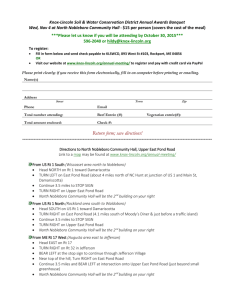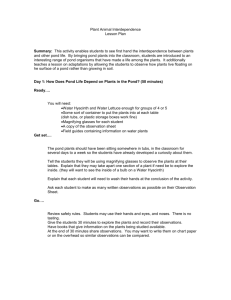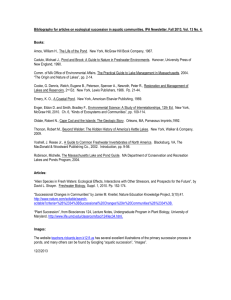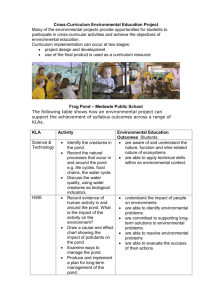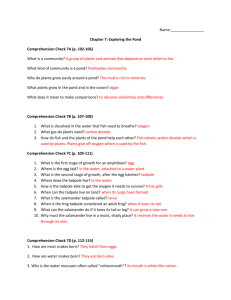N Effects of Salinity and Nutrient Loading on Species Presence
advertisement
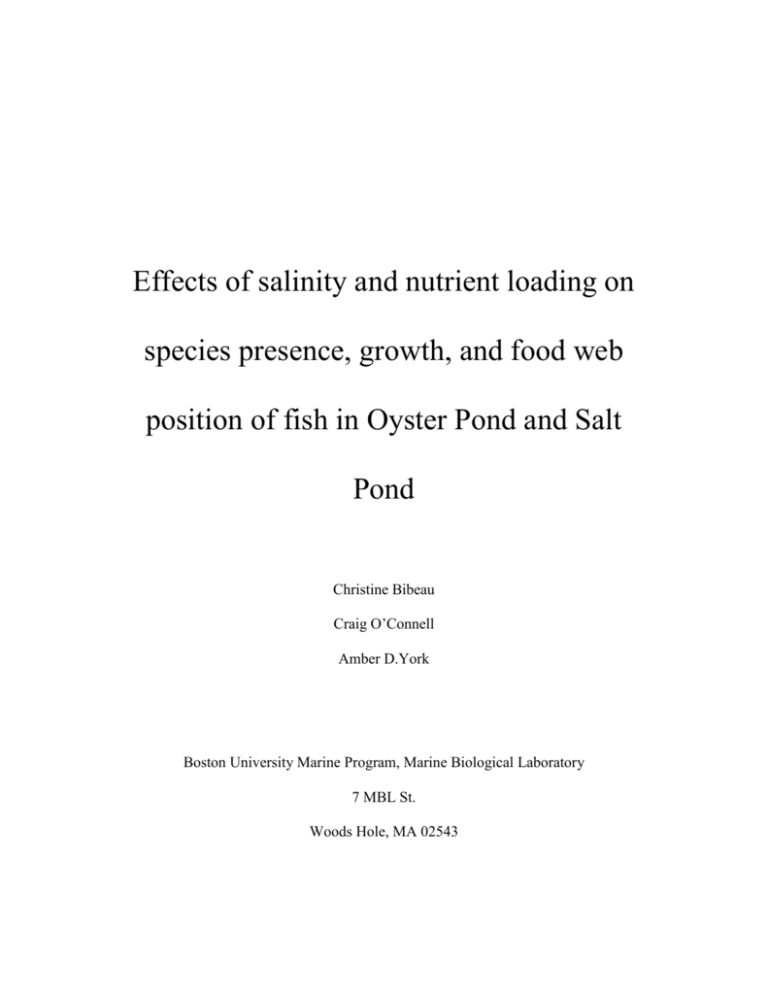
Effects of salinity and nutrient loading on species presence, growth, and food web position of fish in Oyster Pond and Salt Pond Christine Bibeau Craig O’Connell Amber D.York Boston University Marine Program, Marine Biological Laboratory 7 MBL St. Woods Hole, MA 02543 2 ABSTRACT Changing land use increases nutrient loading into coastal environments. This nutrient loading can have harmful effects on fish populations (Justic et al., 2003). Salinity can also affect fish populations. Higher salinities may impede the spawning behaviors of anadromous fish (Limburg, 1998). We compared fish populations within Oyster Pond and the saltier, higher nutrient loaded, Salt Pond. We found some species exclusive to one pond while others were common in both. In Alosa pseudoharengus the growth rate of first year fish was similar between the two ponds. We found higher first year growth rates of Fundulus heteroclitus and Menidia menidia in the more saline pond. Our results suggest that salinity does not have a negative effect on growth of fish. Stable isotope analysis showed us that the fish of both ponds employed diverse feeding strategies, combining various degrees of herbivory and carnivory. Comparison of δ15N values of the species that occurred in both ponds suggested that in Salt Pond, more nitrogen from waste water sources may be entering the food web. Finally, the δ13C of the fish showed us the food webs of the ponds were based on two different sources of fixed carbon. INTRODUCTION Anthropogenic changes, such as changing land use, increase the amount of nutrient loading into coastal ecosystems. Estuary degradation on Cape Cod is well documented (McClelland et al., 1997; McClelland and Valiela, 1998a; McClelland and Valiela, 1998b). High nutrient loading can lead to algal blooms which in turn depletes oxygen levels. Depletion of oxygen levels leads to unfavorable living conditions for 3 aerobic species. Oyster Pond in Falmouth, Massachusetts, is one estuary that has experienced a loss of quality because of human impacts. In the 1980s an increase of salt water entering Oyster Pond caused anoxia, loss of species, and water stratification (Howes and Hart, 1997). Currently a weir maintains an average salinity of 2-3 ppt in Oyster Pond (Bishop and Perret, personal communication). We chose to compare Oyster Pond to Salt Pond (Fig. 1) because Salt Pond receives higher nutrient loads than Oyster Pond (Bishop and Perret, personal communication). Weisberg (1986) concluded certain fish species show preferences for specific ranges of salinity. The current management of Oyster Pond includes maintaining low salinities because of the belief that the growth of A. pseudoharengus juveniles is impeded by higher salinities, an idea that is based on untested observations and is not supported by the current literature (Rutecki, 2003). We compared Oyster Pond (average salinity 2-3 ppt) to Salt Pond (average salinity 25 ppt) because the salinities of the ponds differed, yet alewives were present in both ponds. The breadth of resource partitioning determines how many species can be present in a community (Valiela, 1995). We studied the species presence in both ponds to determine which pond had more species. Size of fish is a measure of how well their environment can support them. We compared the average lengths and growth rates of fish species in Oyster Pond and Salt Pond to see which of the ponds encouraged larger growth. Stable isotope analysis can be used to characterize marine food webs. We compared the range of δ15N values of the fish collected at both ponds to examine their feeding strategies. The δ15N values also allowed us to estimate which of the two ponds 4 was more influenced by the nitrogen inputs from wastewater. Additionally we used δ13C to determine what type of primary producer provided the fixed carbon upon which the food web of each pond was based. The δ13C values of the fish show us what type of producer fixes the carbon that enters the food web of each pond because consumers have 13C signatures very similar to the signatures of their food sources (Gannes et al. 1997). To determine the number of species present at Salt Pond and Oyster Pond, we seined both ponds during the night and day. To calculate growth rates of fish we used cohort mean lengths. To examine the food web position of the fish we used stable isotopic analysis. METHODS We conducted our study in Oyster Pond and Salt Pond, two estuaries located in Falmouth, Massachusetts. Both of these bodies of water are connected to Vineyard Sound, the adjacent source of salt water. In both these ponds, we collected samples during October 2004. Seining Fish samples were collected from both Oyster Pond and Salt Pond. We seined during the day and night to catch to catch both diurnal and nocturnal species. We recorded the species, standard length, and collection site of each fish caught. Growth rate determination By using MIX 3.1.3 software, we determined the number of cohorts present in each group of fish and the mean length of each cohort. We verified cohort ages by counting the number of annuli bands on fish scales. We removed six to ten scales from the head and body of five fish from each of the large, medium, and small size classes of 5 each species from each location. To clean the scales we rinsed them in a 3% H2O2 solution, dried them, and placed them on glass slides. We viewed the scales under a compound microscope at 40x magnification. We determined the age of each fish by counting the number of annuli rings on a scale (Diana, 1995). We calculated growth rates from the mean lengths of fish in each age class with values obtained in the cohort analyses. Growth rate in the first year was equal to the mean of the first cohort length because we assumed fish size at birth to be negligible. Growth rate of the second year cohorts was calculated by subtracting the mean length of the cohort from its mean length in the first year. If a three year age class was present, we subtracted mean length of the cohort at the second year from mean length of the cohort at the third year to determine the growth rate during the third year. Isotopic analysis We used stable isotope analysis to examine the food web position of the fish in this study. 15 N analysis has been used to examine the trophic position of fish in aquatic food webs and to trace flow of wastewater derived nitrogen through estuarine food webs. (Griffin and Valiela, 2001; McClelland and Valiela, 1997; Minagawa and Wada, 1984). 13C isotopic analysis has been shown to be an indicator of which carbon source forms the base of the food web (McClelland and Valiela, 1998b). We selected five small, medium and large individuals from each species for 15N and 13C isotopic analysis. We removed the head, fins, and viscera from each fish. We dried fish in a drying oven at 60C for one to three days. Once the drying process was complete, we removed approximately 0.1g total of muscle, tissue, and bone from various parts of each fish. We ground all the removed mass from the group of fish to a fine 6 powder with a mortar and pestle. We weighed out 1 mg samples of material from each group of fish. The Stable Isotope Facility of the University of California, Davis, conducted 15 N analyses and 13 C analyses. RESULTS AND DISCUSSION We found more species of fish species at Salt Pond than at Oyster Pond (Table 1). Of the 15 species of fish observed in this survey, only three were observed in both ponds. Fundulus heteroclitus, Alosa pseudoharengus, and Menidia menidia were abundant in both ponds. A. pseudoharengus eggs and larvae must stay in the fresher parts of the Salt Pond estuary until juvenile development. Rutecki (2003) reviewed the current literature regarding A. pseudoharengus salinity tolerances and found that A. pseudoharengus eggs only exist in salinities from 0-3 ppt, larvae in 0-10 ppt, and juveniles in 0-32 ppt. In our study we found juvenile A. pseudoharengus of the same size in both ponds suggesting that higher salinities do not slow the growth rate of A. pseudoharengus (Table 2). The higher nutrient content and salinity of Salt Pond do not affect growth rate during the first year of development. A. pseudoharengus juveniles caught in Salt Pond were born in that estuary system because their δ13C signature matched the signature of the main food source within that food web. The average lengths of F. heteroclitus and M. menidia in Salt Pond were significantly higher for all age classes than those of their counterparts in Oyster Pond (Table 3). The annual growth of F. heteroclitus and M. menidia was also greater during their first year of growth at Salt Pond than at Oyster Pond, but growth rates for both 7 ponds were similar in their second year of growth (Table 4). This indicates that after the first year of growth, salinity and nutrient loading did not affect growth rate of these two species. Fish collected from both ponds employ a variety of feeding strategies. The 15N values of the fish in Oyster Pond ranged from 9.37 ‰ to 13.18 ‰. The Salt Pond values ranged from 8.41‰ to 13.00 ‰ (Fig. 4). The 15 N values of Cyprinodon variegatus, 8.41‰- 8.48‰, showed these fish were the most herbivorous. The 15 N values of Morone americana, 11.94‰- 13.18‰, showed these fish were the most carnivorous (Fig. 3). The 15 N values of A. pseudoharengus and F. heteroclitus, but not M. menidia, were higher in Salt Pond than those of the same species in Oyster Pond (Fig. 4). Because nitrate that is derived from wastewater is enriched with 15N relative to 14N, the higher δ15N values from the salt pond group of two of the three species common in both ponds suggest that there may be a greater input of nitrogen from wastewater sources in Salt Pond than in Oyster Pond. The 13C values for Oyster Pond ranged from -18.91‰ to -26.34 ‰. The 13C values for Salt Pond ranged from -12.06 ‰ to -16.09 ‰ with no area of overlap. These values show that Oyster Pond is dominated by fish that feed on prey that derive their carbon from terrestrial plants and some aquatic plants. Similarly, Salt Pond is dominated by fish that feed on prey that derive their carbon from C4 plants, such as the marsh grass, Spartina alterniflora, and some aquatic plants (Fig. 3). These findings show that the two ponds have different food webs. 8 ACKNOWLEDGMENTS We thank Ivan Valiela and Jen Bowen for many helpful comments during the writing of this manuscript. We thank John Galbraith for his fish collecting advice. Lastly, we thank Karen Bishop and Michael Perret for information regarding salinity and nutrient loads within Oyster Pond and Salt Pond. REFERENCES Diana, J. 1995. Biology and Ecology of Fishes. Biological Sciences Press, Carmel, IN. 441 p. Fry, B., and E.B. Sherr. 1984. δ13C measurements as indicators of carbon flow in marine and freshwater ecosystems. Contributions to Marine Science 27: 13-47. Griffin, M.P.A., and I. Valiela. 2001. δ15N isotope studies of life history and trophic position of Fundulus heteroclitus and Menidia menidia. Marine Ecology Progress Series 214: 299-305. Howes, B.L., and S.R. Hart. 1997. Epilogue: Oyster Pond- three decades of change. In A coastal pond studied by oceanographic methods. Oyster Pond Environmental Trust, Inc., Wood Hole, MA. Ichthus Data Systems. 1998. MIX, version 3.1.3. Hamilton, Ontario. Justic, D. and R. E. Turner, and N. N. Rabalais. 2003. Climatic infuluences on Riverine Nitrate Flux: Implications for Coastal Marine Eutrophication and Hypoxia. Esutaries 26: 1-11. 9 Limburg, K. E. 1998. Anomalous migrations of anadromous herrings revealed with natural chemical tracers. Canadian Journal of Fish Aquatic Science 55: 431-437. McClelland, J.W., and I. Valiela. 1998a. Linking nitrogen to estuarine producers to landderived sources. Limnology and Oceanography 43: 577-584. McClelland, J.W., and I. Valiela. 1998b. Changes in food web structure sunder the influence of increased anthropogenic nitrogen inputs to estuaries. Marine Ecology Progress Series 168: 259-271. McClelland, J.W., and I. Valiela., and R. H. Michener. 1997. Nitrogen-stable isotope signatures in estuarine food webs; a record of increasing urbanization in coastal water sheds. Limnology and Oceanography 42: 930-937. Minagawa, M., and E. Wada. 1984. Stepwise enrichment of 15N food chains: Further evidence and the relation between δ15N and animal age. Geochimica et Cosmochimica Acta 48: 1135-1140. Nixon, S.W. and B.A. Buckley. 2002. “A strikingly rich zone”—nutrient enrichment and secondary production in coastal marine ecosystems. Estuaries 25: 782-796. Rutecki, D. 2003. A literature review of the salinity tolearances of alewife (Alosa pseudoharengus), submerged aquatic vegetation and emergent vegetation in Oyster Pond, MA. unpublished report. Valiela, I. 1995. Marine Ecological Processes, second edition. Springer-Verlag New York. Inc. Valiela, I., D. Rutecki, S. Fox. 2004. Salt marshes: biological controls of food webs in a diminishing environment. Journal of Experimental Marine Biology and Ecology 300:131-159. 10 Weisberg, S. B. 1986. Competition and coexistence among four estuarine species of Fundulus. American Zoologist 26: 249-257. FIGURE LEGENDS Figure 1. Map showing the relative proximity of Oyster Pond and Salt Pond. These ponds are located in Falmouth, Massachusetts. Figure 2. Growth rates for two age classes of F. heteroclitus and M. menidia from Salt Pond and Oyster Pond. Y error bars indicate standard error. Figure 3. δ13C of Salt Pond and Oyster Pond fish plotted against their 15N values. Shaded areas indicate the δ13C values of different primary producers. T = terrestrial plants, M = macroalgae, G = marsh grass (Spartina alterniflora), E = eelgrass. The symbols for the fish species are: A = alewife (A. pseudoharengus), B = banded killifish (F. diaphanus), K = striped killifish (F. majalis), M = common mummichog (F. heteroclitus), S = silverside (M. menidia), Sm = sheepshead minnows (C. variegatus), and W = white perch (M. americana). Values for δ13C of macroalgae and eel grass are from McClelland and Valiela (1998). Values for δ13C of Spartina and terrestrial plants are from Fry and Sherr (1984). 11 Figure 4. 15N values for the three abundant species common to both ponds. The 15N values of the Salt Pond fish are plotted against the values of their conspecifics at Oyster Pond. TABLES Table 1. Abundant species collected and site where they were collected. (+) indicates species was present. (-) indicates species was not present. Oyster Salt Species Pond Pond Morone americana + - Anguilla rostrata + - Fundulus diaphanus + - Fundulus heteroclitus + + Alosa pseudoharengus + + Menidia menidia + + Fundulus majalis - + Cyprinodon variegatus - + Total number of species 7 11 12 Table 2. Growth rate (mm y-1) (mean ± s.e.) of A. pseudoharengus in their first year of growth. Asterisks indicate that there is no significant difference between these growth rates (student’s t-test, p= 0.91, df = 9). Growth rate (mm y-1) (mean ± s.e.) Oyster Pond Salt Pond early cohort 72 ± 1 -- late cohort 63 ± 0 -- 64 ± 0 * 63 ± 5 * 714 10 total Sample size 13 Table 3. Lengths(mm) (mean ± s.e.) of the three abundant species of fish common to Oyster Pond and Salt Pond. Asterisks indicate significance (student’s t-test). Species Oyster Pond Salt Pond p-value df A. pseudoharengus 64 ± 0 63 ± 5 0.911 9 F. heteroclitus 26 ± 1 68 ± 2 <0.001* 48 M. menidia 48 ± 0 62 ± 1 <0.001* 382 14 Table 4. Number of age classes, cohorts per age class, and length (mean ± s.e.) for the three species present in abundance in both ponds. Values were obtained from MIX 3.1.3. as described in methods section. Species A. pseudoharengus Annual age Location classes Oyster 1 Cohorts per annual age class 2 F. heteroclitus Oyster 2 1 F. heteroclitus Salt 2 1 M. menidia Oyster 2 1 M. menidia Salt 2 1 Length (mm) (mean ± s.e) 63 ± 0 72 ± 1 28 ± 0 63 ± 3 59 ± 5 84 ± 4 43 ± 1 48 ± 0 57 ± 0 67 ± 2 Annual growth (mm y-1) (mean ± s.e.) 63 ± 0 72 ± 1 28 ± 0 35 ± 5 59 ± 5 25 ± 6 43 ± 1 5±1 57 ± 0 10 ± 2 15 FIGURES Figure 1. 16 Annual growth (mm y-1) Figure 2. F. heteroclitus Oyster Pond 60 Salt Pond 40 20 SP OP OP 0 01 Annual growth (mm y-1) SP 12 M. menidia 60 Oyster Pond Salt Pond 40 SP 20 OP SP OP 0 10 Age (years) 21 17 Figure 3. 18 Oyster Pond 15 δ N (‰) T 14 13 12 11 10 9 8 7 M G E W S S A -30 -25 W B MB M M -20 -15 -10 -5 δ13C (‰) Salt Pond 15 δ N (‰) T M 14 13 12 11 10 9 8 7 G A M K M K K S SmSm -30 -25 -20 -15 δ13C (‰) Figure 4. E -10 -5 15 δ N (‰) of fish in Oyster Pond 19 15 1:1 14 13 Menidia menida 12 Alosa pseudoharengus 11 Fundulus heteroclitus 10 Fundulus heteroclitus 9 9 10 11 12 13 14 δ15N (‰) of fish in Salt Pond 15



